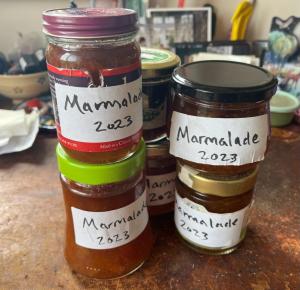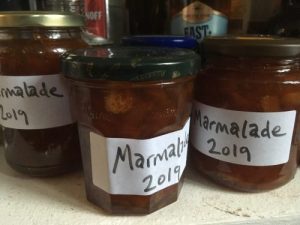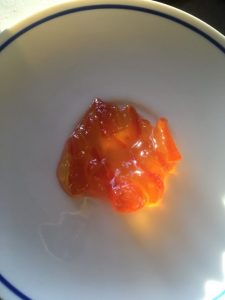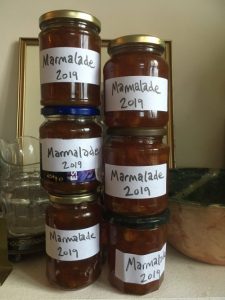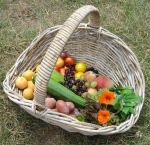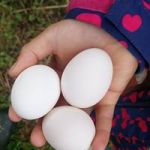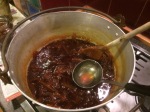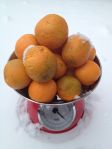
Oranges snow today
The cookery writer, Katie Stewart, died earlier this month.
There was an outpouring on Twitter from those including me who had learned to cook from her cookbooks.
Then Guardian food and wine writer, Fiona Beckett, suggested a Katie Cook (#katiestewart) day and others on Twitter took up the call, followed by Alex Renton in The Times. This is my contribution.
I have been following Katie Stewart’s helpful, practical recipe for making chunky marmalade since 1980 from The Times Calendar Cookbook. Having decreased sugar bit by bit, I now use less sugar than fruit.
Katie’s original amounts: 3 lbs/ 1.1/4 kg Seville oranges | 6lbs / 2.3/4 kg sugar | 5 pts/ 2.3/4 litres water | juice of 2 lemons.
I use organic Seville oranges. They cost twice as much this year as non-organic ones because we live in a nutty world where wholesome food is more expensive than junk food. Still, added expense worth it because:
- Organic oranges have more pronounced taste because they are smaller and denser (basically less watery) than non-organic oranges
- More nutrients in organic too: “conventional farmers (drive) down nutrient levels via their pursuit of ever-higher yields,” says Charles M. Benbrook
- By paying the extra, I am doing my bit for healthier soils and water, and feeding the world. Think of it as a charity donation.
Talking of which, Katie Stewart’s family has asked for donations (rather than flowers) for The Kids’ Cookery School. The charity’s mission is to give every child in the UK an unique fun cooking experience to help them make informed choices about food. You can donate online.
My marmalade 2001 blog post talks about the young US soldier, Bradley Manning, Wikileaks whistleblower. Currently in pre-trial court martial proceedings, on Thursday he was refused the whistleblower’s defence: motive.
The marmalade: Katie Stewart’s recipe for Chunky Seville Marmalade, her invaluable tips, my amounts and spin on my Marmalade 2011. Apologies not metric – any help with converting amounts welcome.
Marmalade
5lbs organic Seville oranges
4 lbs organic cane sugar
2 lemons
4 pts of water + 1 pt for extracting pectin
Top Katie Tips
- Place a few saucers in freezer so boiling jam can cool quickly when testing to see it has set
- Put weighed sugar in a preserving pan in low oven to warm
- Clean jars thoroughly with hot water and dry them in oven
- Add lemons at preserving pan stage.
Five stages of making marmalade
1. Clean oranges + simmer to soften
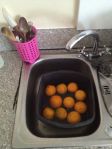
Scrub non-organic oranges and remove stalks. Cook in a large pan or two smaller ones – with lids – in 4 pints of water and simmer heartily for about an hour until peel is soft. Orangey aroma fills room…
Drain cooked whole oranges and preserve cooking water as if it were a precious liquid (it is).
This process can be done earlier, or even the day before.
2. Extracting pith and pips for pectin

Pith and pips (left)
Pectin, extracted from the insides of the fruit, is the setting agent. Cut cooked-and-cooled oranges in half. Scoop out with spoon the oranges’ insides – the pith and pips (pith and pips pith and pips – say it quickly) .
Add pith and pips to large pan with the 1 extra pint of water. Simmer for ten minutes then drain: this pectin-rich liquid will help jam set in Stage 4.
3. Slicing peel

Flatten softened peel with your hand, and cut up peel of oranges (and lemons), thinly or thickly, as you like.
4. Sugar boiling drama

Fast-boil for imminent set
Add the sugar (warmed from the oven) to a preserving pan. Strongly suggest a preserving pan is good investment – otherwise use two of your widest pans.
Add the precious-liquid (stage 1), drained pectin-juice (stage 2), and cut-up peel (stage 3) in with sugar in preserving pan. Start boiling…
You must not overboil or you can lose that magic-setting moment. It really is as terrifying as it sounds. But you know what they say: the other side of fear is excitement.
It takes about 20-30 minutes to get it to boiling temperature and then you have to watch it like a hawk.
Start timing your 15-20 minutes when the jam is boiling like mad i.e. not just bubbling but when liquid goes into a furious fast-boiling glucky whirl – then start timing those 15-20 minutes.
So, after 15 minutes, take the pan off the heat and drop some hot jam on one of those icy-cold plates.
Let jam-droplet cool, tilting plate to encourage cooling, then push droplet gently with your finger. You are looking for tell-tale wrinkles and jelly-like character. (The opposite of an ideal lover? My 2011 joke).
If droplet is still runny, carry on boiling the big pan for a few minutes then test again. And so on.
Stage 5. Marmalade in jars

The marmalade droplets are now unequivocally set. Let jam cool in pan until not-too-hot nor too-set for pouring . Next, the sticky bit. Use newspaper to cover kitchen surface, use a ladle or a small cup. Good luck.
Recipes say use waxed discs to keep out condensation and mould but, cutting-corners-cook that I am, I have not not done so for years, with no adverse effects. Wipe jars from stickiness and proudly label.

0.000000
0.000000
